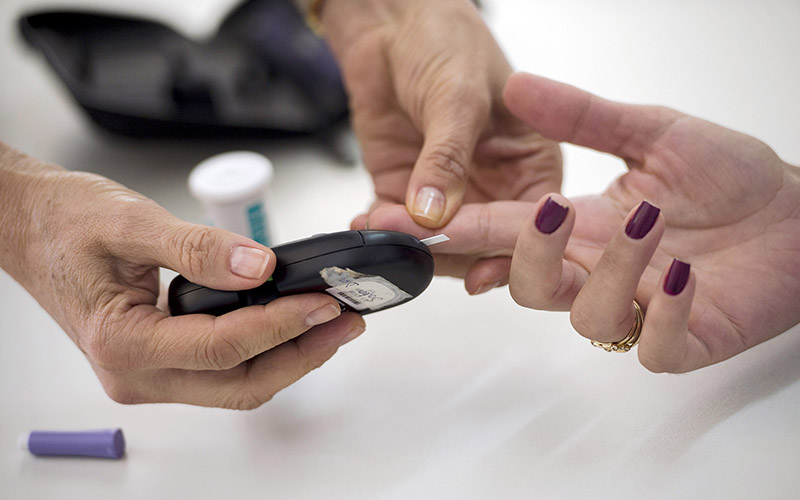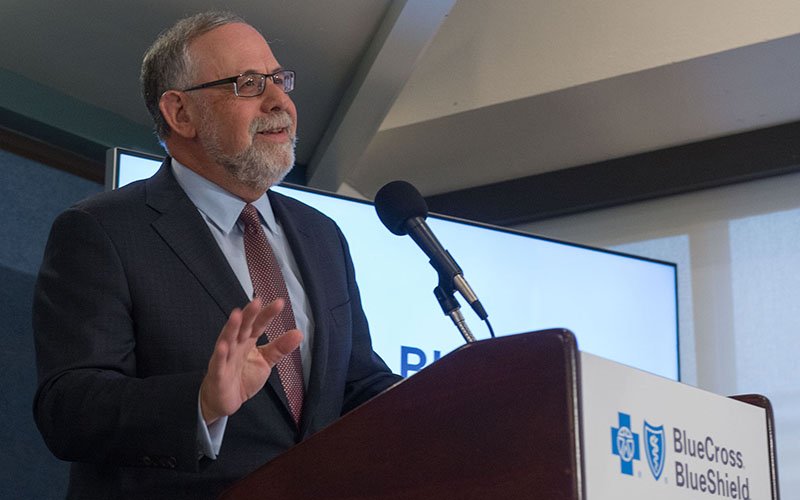
A woman has her blood sugar tested. Diabetes was cited as the major health challenge in six of Arizona’s counties in a new national study. (Photo by Marcelo Camargo, Agencia Brasil/Creative Commons)

Blue Cross Blue Shield Association President and CEO Scott Serota said the health index was done because “when you measure healthcare you can improve healthcare.” (Photo by John Harrington/Blue Cross Blue Shield)

Diabetes, hypertension and depression and mood disorders were the top health problems for Arizona counties in a national study of county health. (Photo by Bradley Johnson/Creative Commons)
WASHINGTON – Diabetes, hypertension and depression are the biggest problems facing Arizona counties, according to a new nationwide health index map that also scored counties on whether they tend to be more healthy or less.
The report Tuesday by the Blue Cross Blue Shield Association looked at every county where the insurer has clients and was issued, sponsors said, to help local governments focus health improvement efforts where they can do the most good.
In Arizona, where the report scored every county but Greenlee, the biggest issue was identified as diabetes in six counties, hypertension in four counties and depression, anxiety and other mood disorders in the remaining four. The report said nine of the 14 Arizona counties measured got scores higher than the national average of 0.924 on its scale of zero to one.
“The index provides a sharpened focus on the local level understanding of health, so that we can collaborate on solutions to meet unique community needs while improving our nation’s health as a whole,” said Daniel J. Hilferty, president and CEO of Independence Blue Cross in Philadelphia.
Hilferty said at the Tuesday release of the “first of its kind” index that it is just another example of how insurance companies can “come together to improve the health of all Americans.”
State and county health officials were not immediately available Tuesday to comment on the report, but the director of the University of Arizona’s Center for Rural Health said he was not surprised by its findings on the biggest challenges facing counties in the state.
Dr. Daniel Derksen said it is not unusual for the state’s rural counties to have health issues related to diabetes, noting that counties with large numbers of Latino or Native American residents “tend to have higher rates of diabetes.” He pointed to two counties in the report where diabetes is the No. 1 problem, Yuma and Navajo, that have high numbers of Latinos and Native Americans, respectively.
But he also said that many counties in the state face a combination of problems that include diabetes, hypertension and hypercholesterolemia that “contribute significantly to poorer health outcomes and much higher costs of care.”
“Focusing public and population health interventions in these higher-risk populations and areas … would improve outcomes and control cost growth” in medical spending, he said.
Mark Zandi, chief economist of Moody’s Analytics, said the map reflects economics as well as demographics.
“The BCBS Health Index shows that health and the economy’s performance go hand in hand,” Zandi said. “Policymakers can use the BCBS Health Index to better understand how health outcomes impact economic growth.”
That point was echoed by Maureen Sullivan, chief strategy and innovation officer for the association, who said the Blue Cross Blue Shield data “presents tremendous potential for business leaders, medical professionals and policymakers to have data-driven conversations about how to enhance the overall quality of life.”
In addition to identifying the top health issues in each county, the report ranked county health on a zero-to-one scale, with zero being “less healthy” and one “more healthy.”
A 0.9 rating indicates that a county has reached ” 90 percent of its optimal health and could gain up to 10 percent in healthy lifespan by tackling the top conditions that impact that community,” said Scott Serota, president and CEO the Blue Cross Blue Shield Association.
No county in the nation got less than a 0.8 score. In Arizona, the scores ranged from a high of 0.948 in Santa Cruz County to a low of 0.885 in La Paz, one of five counties – with Gila, Mohave, Navajo and Yavapai – to fall below the national average of 0.924.
Serota said Tuesday that “when you measure healthcare you can improve healthcare.”
“There’s an old adage, ‘What gets measured, is what gets done,'” Serota said. “We believe in that. Without measurement, you don’t know where you are, you don’t know where you’re going and you can’t find a path to get there.”